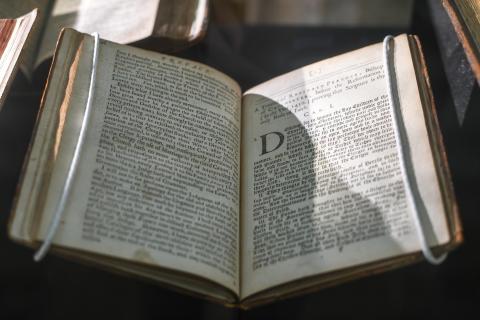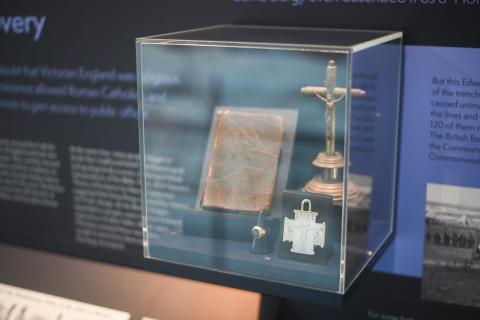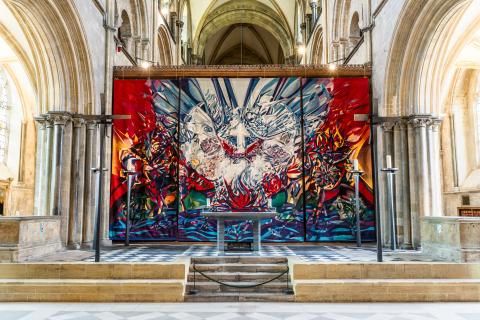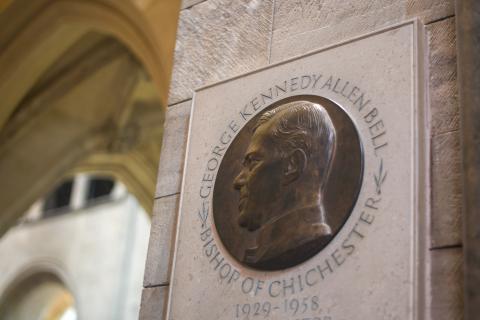As spiritual leaders, advisors and reformers, the bishops of Chichester have helped shape not only the Cathedral and city, but local society and culture.
Our blog series, which explores the stories behind the artefacts within our Chichester950 exhibition Religion, Rebellion & Reformation, has already uncovered some of the symbols of office held by medieval bishops, highlighting both their spiritual and political authority in turbulent times. However, the impact of Chichester’s bishops didn’t end in the Middle Ages.
Within this compelling exhibition exploring the rich history of faith in Sussex over the past 950 years, two bishops emerge as figures who helped reshape the world - through courage and conviction.
Reginald Peacock: Radical thinker, fallen heretic
In 1451, Reginald Peacock was appointed to Chichester as bishop - a prestigious moment that marked the height of his ecclesiastical career. But it was his writing, rather than his rank within the church, that would leave a lasting mark on history.
Peacock was the very first theologian in England to write systematically in English. At a time when theological debate was conducted in Latin and largely confined to the clergy, he broke new ground by bringing complex spiritual ideas into the common tongue. His bookA treatise proving scripture to be the rule of faith c1450, was written first in English and only later adapted into a simplified Latin version, which was then retranslated into English. This layered process made his work far more accessible than traditional theological texts and marked a bold attempt to democratise knowledge and open debate to wider society.
“Peacock’s work is a fascinating story of the democratisation of ideas. It also reflects a critical turning point: a shift from a largely visual and oral religious culture to one that was increasingly rooted in reading, personal interpretation and intellectual enquiry. In writing for a wider audience, he invited ordinary people to engage with theology - to think for themselves, to question, to reflect.”
Reverend Vanessa Baron, Canon Treasurer and exhibition curator
But such openness came at a cost. He was condemned as a heretic and removed from office. Sent into internal exile at Thorney Abbey near Peterborough, he died less than a year later in 1457 - likely from cold, malnutrition and isolation.
Even in disgrace, however, his influence endured. By daring to write theology in the language of the people, Peacock helped lay the intellectual groundwork for future reformers. His story, and the rare copy of his writings held in the Cathedral Library, feature in the Religion, Rebellion & Reformation exhibition - not just as relics of dissent, but as milestones in the long journey towards open debate and individual understanding in matters of faith.

George Bell: Moral courage in wartime
Nearly 500 years later, another bishop of Chichester took a bold and unpopular stand. George Bell, bishop from 1929 to 1958, spoke out publicly against the allied bombing of German cities during the Second World War. While many saw these attacks - such as the carpet bombing of Dresden - as necessary acts of war, Bell saw something different: a moral line that had been crossed.
He condemned the bombing of civilian populations in Parliament and in print, standing virtually alone among senior churchmen of his time. It was a position that may have cost him the Archbishopric of Canterbury, but it cemented his legacy as a voice of conscience when it mattered most.
In our Religion, Rebellion & Reformation exhibition, visitors can see several of Bishop Bell’s personal items, including a cross he wore around his neck, as well as the Relic of the True Cross, which sat on his desk as a personal reminder of Christ’s sacrifice for the world’s sin, and his episcopal ring. These artefacts are simple, quiet objects that witnessed a life of conviction and action.

Bell’s connection to Germany ran deeper than wartime protest. He championed reconciliation after the war, building bridges with German churches and communities devastated by conflict. His belief in the power of culture to rebuild society found expression in a series of artistic commissions that still shape the Cathedral today.
The arts in the service of peace
Bell’s vision was to re-establish the link between the Church and the arts, seeing creativity not as decoration, but as a vital force for healing. An example of this is the Anglo-German tapestry, also known as the Reconciliation Tapestry, by German artist Ursula Benker-Schirmer. It illustrates the life of St Richard and symbolises reconciliation between Britain and Germany.

Enduring influence
Today, a memorial to Bishop George Bell stands in Chichester Cathedral. Together with Bishop Reginald Peacock - who dared to make sacred ideas accessible - Bell reminds us that the power of a bishop does not lie only in croziers or rings, but in the moral authority to stand apart and to speak out.

Religion, Rebellion & Reformation is part of Chichester Cathedral’s 950th anniversary programme and is on display until Saturday 15th November 2025. The exhibition is free to visit, with a suggested donation of £7.00 per person. The Cathedral is open from Monday – Saturday 9.00am – 5.00pm and on Sunday from 12.30pm – 2.30pm.